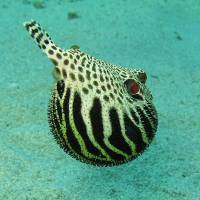 Tetraodontidae is a family of primarily marine and estuarine fish of the order Tetraodontiformes. The family includes many familiar species, which are variously called pufferfish, puffers, balloonfish, blowfish, bubblefish, globefish, swellfish, toadfish, toadies, honey toads, sugar toads, and sea squab. Pufferfish are generally believed to be the second-most poisonous vertebrates in the world, after the golden poison frog. They are most diverse in the tropics, relatively uncommon in the temperate zone, and completely absent from cold waters. They are typically small to medium in size, although a few species can reach lengths of greater than 100 cm (39 in). The puffer's unique and distinctive natural defenses help compensate for its slow locomotion. It moves by combining pectoral, dorsal, anal, and caudal fins. This makes it highly maneuverable, but very slow, and therefore a comparatively easy predation target. Its tail fin is mainly used as a rudder, but it can be used for a sudden evasive burst of speed that shows none of the care and precision of its usual movements. The puffer's excellent eyesight, combined with this speed burst, is the first and most important defense against predators. Puffers are able to move their eyes independently, and many species can change the color or intensity of their patterns in response to environmental changes. In these respects, they are somewhat similar to the terrestrial chameleon. Although most puffers are drab, many have bright colors and distinctive markings, and make no attempt to hide from predators.
Tetraodontidae is a family of primarily marine and estuarine fish of the order Tetraodontiformes. The family includes many familiar species, which are variously called pufferfish, puffers, balloonfish, blowfish, bubblefish, globefish, swellfish, toadfish, toadies, honey toads, sugar toads, and sea squab. Pufferfish are generally believed to be the second-most poisonous vertebrates in the world, after the golden poison frog. They are most diverse in the tropics, relatively uncommon in the temperate zone, and completely absent from cold waters. They are typically small to medium in size, although a few species can reach lengths of greater than 100 cm (39 in). The puffer's unique and distinctive natural defenses help compensate for its slow locomotion. It moves by combining pectoral, dorsal, anal, and caudal fins. This makes it highly maneuverable, but very slow, and therefore a comparatively easy predation target. Its tail fin is mainly used as a rudder, but it can be used for a sudden evasive burst of speed that shows none of the care and precision of its usual movements. The puffer's excellent eyesight, combined with this speed burst, is the first and most important defense against predators. Puffers are able to move their eyes independently, and many species can change the color or intensity of their patterns in response to environmental changes. In these respects, they are somewhat similar to the terrestrial chameleon. Although most puffers are drab, many have bright colors and distinctive markings, and make no attempt to hide from predators.
